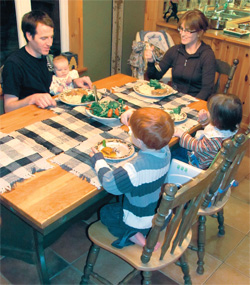From 1 year onward—sharing meals with the family

![]() By age 1 or so, she will be eating most of the same foods as the rest of the family.
By age 1 or so, she will be eating most of the same foods as the rest of the family.
Your child now has a highly varied diet that includes almost all the same foods your family eats. He shares the three main meals of the day with you and probably needs one or two snacks as well.
At this age the growth rate starts to slow down a bit. His appetite may decrease or vary from day to day.
Because your child loves to explore and play, he may also be less interested in food. Although this change worries many parents, there is no need for concern as long as your child is healthy and happy, having fun, and developing normally.
Developing good habits
![]() What matters is to adapt food quantities to your child’s needs, based on his preferences and appetite.
What matters is to adapt food quantities to your child’s needs, based on his preferences and appetite.
As much as possible, accustom your child to eating the same meals as the rest of the family. You can start giving him homemade foods and dishes containing a little bit of salt (e.g., spaghetti sauce) or sugar (e.g., muffins).
One good way to provide a balanced diet: at every meal, try to include foods from at least three of the four food groups shown on the preceding pages.
You can take inspiration from the Food Guide Snapshot, which presents balanced meal ideas for the whole family: food-guide.canada.ca/en/food-guide-snapshot/.
Good to know...
Cow’s milk is enriched with vitamin D. At around 1 year, children should drink 500 ml (16 oz.) of whole cow’s milk (3.25% milk fat) a day to get part of the vitamin D they need (see Vitamin D: Not your ordinary vitamin!).
But don’t serve more than 750 ml (25 oz.) of milk a day or you risk spoiling your child’s appetite for other foods.
Ingredients to limit
Some ingredients can be bad for your baby and other family members if consumed in excess. Limit consumption of the following:
- Salt
- All forms of sugar (sucrose, glucose, fructose, etc.)
- Sugar substitutes (e.g., aspartame, sucralose)
- Fats and oils containing harmful fats (shortening, hydrogenated oils, coconut oil, palm oil, palm kernel oil, etc.)
It’s best to prepare homemade meals using simple, minimally processed ingredients. For example, choose plain rice instead of prepared rice containing added ingredients.
Making family meals easier

![]() The pleasure of eating together!
The pleasure of eating together!
- At mealtime, avoid distractions such as electronic devices and toys.
- Serve small portions to keep your child from getting discouraged.
- Don’t force your child to eat everything on the plate.
- Wait until your child has finished the main course before serving dessert to other family members. This will help maintain interest in the meal.
- Serve nutritious desserts like fruit salad and stewed fruit, yogurt, homemade cookies and muffins, and milk desserts.
CLSC services
CSLCs may offer various nutrition and diet-related services for children under 2 years of age. To find out about the services available in your area, contact your local CLSC.


